A Practical Guide to TPM 2.0
Contents at a Glance
About ApressOpen
Contents
About the Authors
About the Technical Reviewers
Acknowledgments
Introduction
Chapter 1: History of the TPM
Why a TPM?
History of Development of the TPM Specification from 1.1b to 1.2
How TPM 2.0 Developed from TPM 1.2
History of TPM 2.0 Specification Development
Summary
Chapter 2: Basic Security Concepts
Cryptographic Attacks
Brute Force
Calculating the Strength of Algorithms by Type
Attacks on the Algorithm Itself
Security Definitions
Cryptographic Families
Secure Hash (or Digest)
Hash Extend
HMAC: Message Authentication Code
KDF: Key Derivation Function
Authentication or Authorization Ticket
Symmetric-Encryption Key
Symmetric-Key Modes
Nonce
Asymmetric Keys
RSA Asymmetric-Key Algorithm
RSA for Key Encryption
RSA for Digital Signatures
ECC Asymmetric-Key Algorithm
ECDH Asymmetric-Key Algorithm to Use Elliptic Curves to Pass Keys
ECDSA Asymmetric-Key Algorithm to Use Elliptic Curves for Signatures
Public Key Certification
Summary
Chapter 3: Quick Tutorial on TPM 2.0
Scenarios for Using TPM 1.2
Identification
Encryption
Key Storage
Random Number Generator
NVRAM Storage
Platform Configuration Registers
Privacy Enablement
Scenarios for Using Additional TPM 2.0 Capabilities
Algorithm Agility (New in 2.0)
Enhanced Authorization (New in 2.0)
Quick Key Loading (new in 2.0)
Non-Brittle PCRs (New in 2.0)
Flexible Management (New in 2.0)
Identifying Resources by Name (New in 2.0)
Summary
Chapter 4: Existing Applications That Use TPMs
Application Interfaces Used to Talk to TPMs
TPM Administration and WMI
The Platform Crypto Provider
Virtual Smart Card
Applications That Use TPMs
Applications That Should Use the TPM but Don’t
Building Applications for TPM 1.2
TSS.Net and TSS.C++
Wave System s Embassy Suite
Rocks to Avoid When Developing TPM Applications
Microsoft BitLocker
IBM File and Folder Encryption
New Manageability Solutions in TPM 2.0
Summary
Chapter 5: Navigating the Specification
TPM 2.0 Library Specification: The Parts
Some Definitions
General Definitions
Definitions of the Major Fields of the Command Byte Stream
Definitions of the Major Fields of the Response Byte Stream
Getting Started in Part 3: the Commands
Data Details
Common Structure Constructs
TPM2B_XXX Structures
Structure with Union
Canonicalization
Endianness
Part 2: Notation Syntax
Part 3: Table Decorations
Commonly Used Sections of the Specification
How to Find Information in the Specification
Strategies for Ramping Up on TPM 2.0
Will
Ken
Dave
Other TPM 2.0 Specifications
Summary
Chapter 6: Execution Environment
Setting Up the TPM
Microsoft Simulator
Building the Simulator from Source Code
Setting Up a Binary Version of the Simulator
Running the Simulator
Testing the Simulator
Python Script
TSS.net
System API Test Code
Setting Up the Software Stack
TSS 2.0
TSS.net
Summary
Chapter 7: TPM Software Stack
The Stack: a High-Level View
Feature API
System API
Command Context Allocation Functions
Command Preparation Functions
Command Execution Functions
Command Completion Functions
Simple Code Example
System API Test Code
TCTI
TPM Access Broker ( TAB)
Resource Manager
Device Driver
Summary
Chapter 8: TPM Entities
Permanent Entities
Persistent Hierarchies
Ephemeral Hierarchy
Dictionary Attack Lockout Reset
Platform Configuration Registers ( PCR s)
Reserved Handles
Password Authorization Session
Platform NV Enable
Nonvolatile Indexes
Objects
Nonpersistent Entities
Persistent Entities
Entity Names
Summary
Chapter 9: Hierarchies
Three Persistent Hierarchies
Platform Hierarchy
Storage Hierarchy
Endorsement Hierarchy
Privacy
Activating a Credential
Other Privacy Considerations
NULL Hierarchy
Cryptographic Primitives
Random Number Generator
Digest Primitives
HMAC Primitives
RSA Primitives
Symmetric Key Primitives
Summary
Chapter 10: Keys
Key Commands
Key Generator
Primary Keys and Seeds
Persistence of Keys
Key Cache
Key Authorization
Key Destruction
Key Hierarchy
Key Types and Attributes
Symmetric and Asymmetric Keys Attributes
Duplication Attributes
Restricted Signing Key
Restricted Decryption Key
Context Management vs. Loading
NULL Hierarchy
Certification
Keys Unraveled
Summary
Chapter 11: NV Indexes
NV Ordinary Index
NV Counter Index
NV Bit Field Index
NV Extend Index
Hybrid Index
NV Access Controls
NV Written
NV Index Handle Values
NV Names
NV Password
Separate Commands
Summary
Chapter 12: Platform Configuration Registers
PCR Value
Number of PCRs
PCR Commands
PCRs for Authorization
PCRs for Attestation
PCR Quote in Detail
PCR Attributes
PCR Authorization and Policy
PCR Algorithms
Summary
Chapter 13: Authorizations and Sessions
Session-Related Definitions
Password, HMAC, and Policy Sessions: What Are They?
Session and Authorization: Compared and Contrasted
Authorization Roles
Command and Response Authorization Area Details
Command Authorization Area
Command Authorization Structures
Response Authorization Structures
Password Authorization: The Simplest Authorization
Password Authorization Lifecycle
Creating a Password Authorized Entity
Changing a Password Authorization for an Already Created Entity
Using a Password Authorization
Code Example: Password Session
Starting HMAC and Policy Sessions
TPM2_StartAuthSession Command
Session Key and HMAC Key Details
Guidelines for TPM2_StartAuthSession Handles and Parameters
Session Variations
Salted vs. Unsalted
Bound vs. Unbound
Use Cases for Session Variations
HMAC and Policy Sessions: Differences
HMAC Authorization
HMAC Authorization Lifecycle
Altering or Creating an Entity That Requires HMAC Authorization
Creating an HMAC Session
Using an HMAC Session to Authorize a Single Command
HMAC and Policy Session Code Example
Using an HMAC Session to Send Multiple Commands (Rolling Nonces)
HMAC Session Security
HMAC Session Data Structure
Policy Authorization
How Does EA Work?
Policy Authorization Time Intervals
Policy Authorization Lifecycle
Building the Entity’s Policy Digest
Creating the Entity to Use the Policy Digest
Starting the Real Policy Session
Sending Policy Commands to Fulfill the Policy
Performing the Action That Requires Authorization
Combined Authorization Lifecycle
Summary
Chapter 14: Extended Authorization (EA) Policies
Policies and Passwords
Why Extended Authorization?
Multiple Varieties of Authentication
Multifactor Authentication
How Extended Authorization Works
Creating Policies
Simple Assertion Policies
Passwords (Plaintext and HMAC) of the Object
Passwords of a Different Object
Digital Signatures (such as Smart Cards)
PCRs: State of the Machine
Locality of Command
Internal State of the TPM (Boot Counter and Timers)
Internal Value of an NV RAM Location
State of the External Device (GPS, Fingerprint Reader, and So On)
Flexible (Wild Card) Policy
Example 1: Smart card and Password
Example 2: A Policy for a Key Used Only for Signing with a Password
Example 3: A PC state, a Password, and a Fingerprint
Example 4: A Policy Good for One Boot Cycle
Example 5: A Policy for Flexible PCRs
Example 6: A Policy for Group Admission
Example 7: A Policy for NV RAM between 1 and 100
Command-Based Assertions
Multifactor Authentication
Compound Policies: Using Logical OR in a Policy
Making a Compound Policy
Example: A Policy for Work or Home Computers
Considerations in Creating Policies
End User Role
Administrator Role
Understudy Role
Office Role
Home Role
Using a Policy to Authorize a Command
Starting the Policy
Satisfying a Policy
Simple Assertions and Multifactor Assertions
If the Policy Is Compound
If the Policy Is Flexible (Uses a Wild Card)
Satisfying the Approved Policy
Transforming the Approved Policy in the Flexible Policy
Certified Policies
Summary
Chapter 15: Key Management
Key Generation
Templates
Key Trees: Keeping Keys in a Tree with the Same Algorithm Set
Duplication
Key Distribution
Key Activation
Key Destruction
Putting It All Together
Example 1: Simple Key Management
Example 2: An Enterprise IT Organization with Windows TPM 2.0 Enabled Systems
Summary
Chapter 16: Auditing TPM Commands
Why Audit
Audit Commands
Audit Types
Command Audit
Session Audit
Audit Log
Audit Data
Exclusive Audit
Summary
Chapter 17: Decrypt/Encrypt Sessions
What Do Encrypt/Decrypt Sessions Do?
Practical Use Cases
Decrypt/Encrypt Limitations
Decrypt/Encrypt Setup
Pseudocode Flow
Sample Code
Summary
Chapter 18: Context Management
TAB and the Resource Manager: A High-Level Description
TAB
Resource Manager
Resource Manager Operations
Management of Objects, Sessions, and Sequences
TPM Context-Management Features
TPM Internal Slots
Special Error Codes
TPM Context-Management Commands
Special Rules Related to Power and Shutdown Events
State Diagrams
Summary
Chapter 19: Startup, Shutdown, and Provisioning
Startup and Shutdown
Startup Initialization
Provisioning
TPM Manufacturer Provisioning
Platform OEM Provisioning
End User Provisioning
Deprovisioning
Summary
Chapter 20: Debugging
Low-Level Application Debugging
The Problem
Analyze the Error Code
Debug Trace Analysis
More Complex Errors
Last Resort
Common Bugs
Debugging High-level Applications
Debug Process
Typical Bugs
Authorization
Disabled Function
Missing Objects
Wrong Type
Bad Size
Policy
Summary
Chapter 21: Solving Bigger Problems with the TPM 2.0
Remote Provisioning of PCs with IDevIDs Using the EK
Technique 1
Technique 2
Technique 3
Data Backups
Separation of Privilege
Securing a Server’s Logon
Locking Firmware in an Embedded System, but Allowing for Upgrades
Summary
Chapter 22: Platform Security Technologies That Use TPM 2.0
The Three Technologies
Some Terms
Intel® Trusted Execution Technology (Intel® TXT)
High-Level Description
Intel TXT Platform Components
Intel TXT Boot Sequence
How TPM 2.0 Devices Are Used
NV Indices
PCRs
Conclusion: Intel TXT
ARM® TrustZone®
High-Level Description
TrustZone Is an Architectural Feature
Protection Target
System-Wide Security
Implementation of TrustZone
The NS bit
The Monitor
World Switching
Interrupts
Relationship to TPMs
AMD Secure Technology™
Hardware Validated Boot
TPM on an AMD Platform
SKINIT
Summary
Index
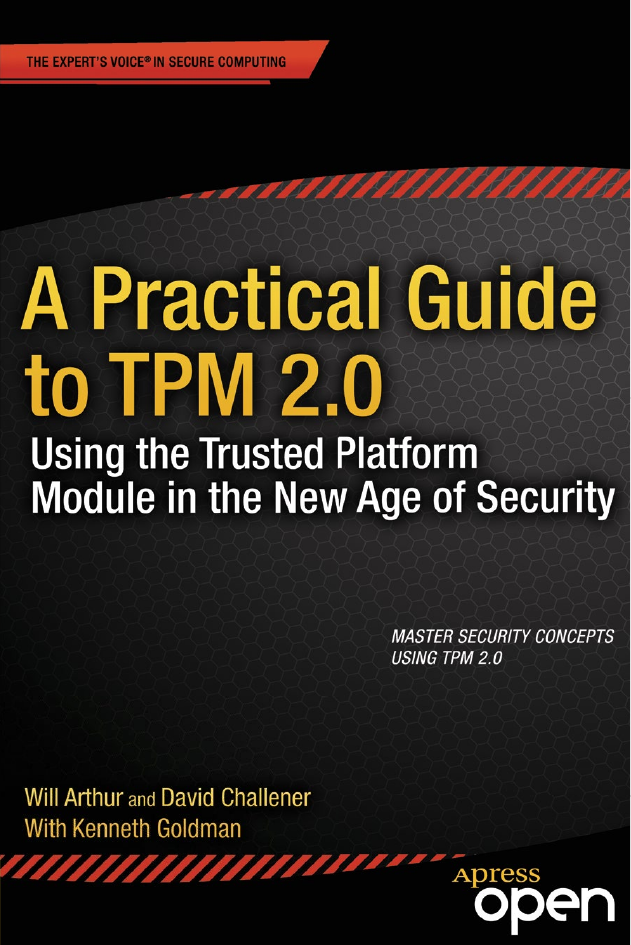

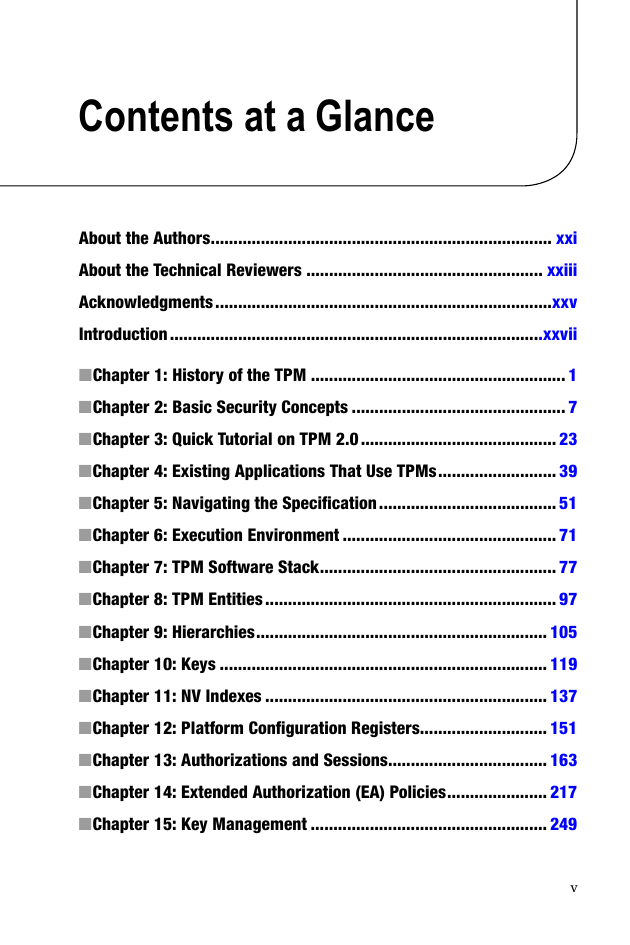
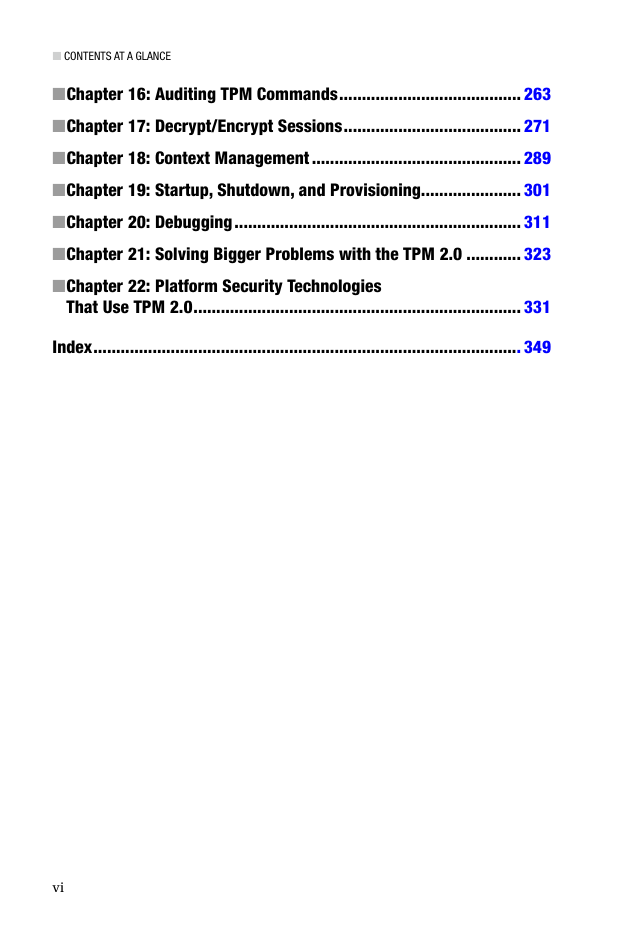
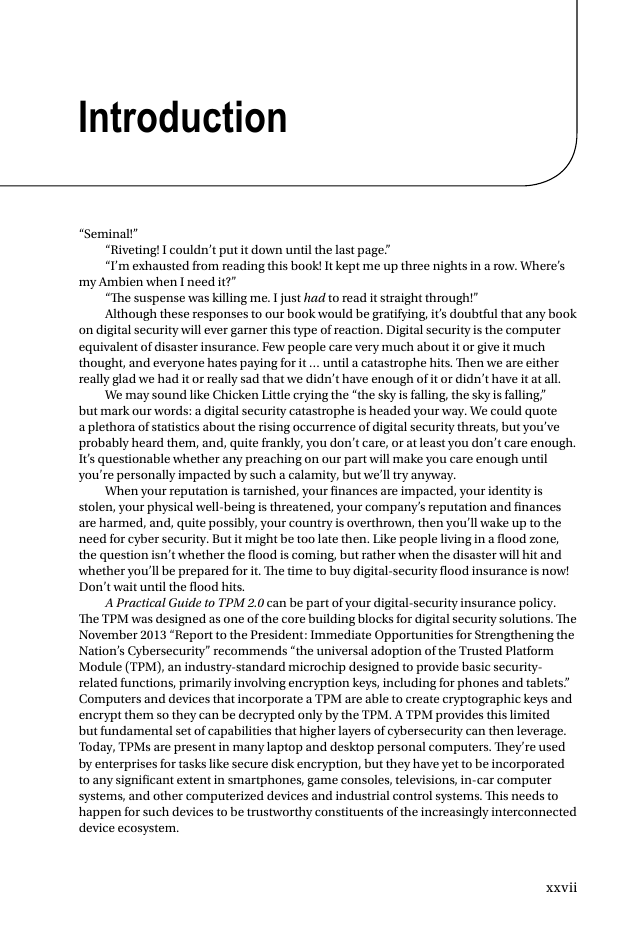
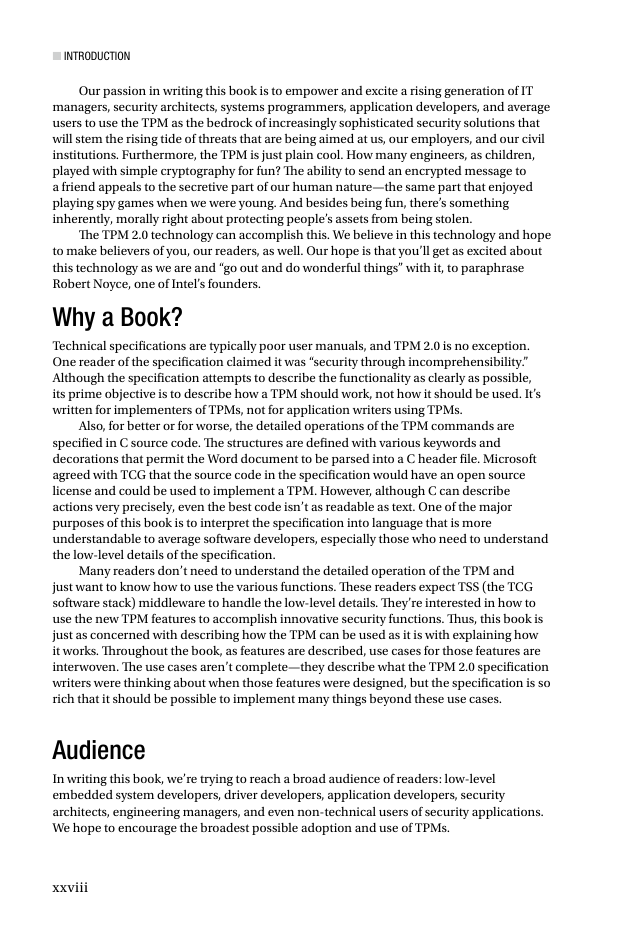
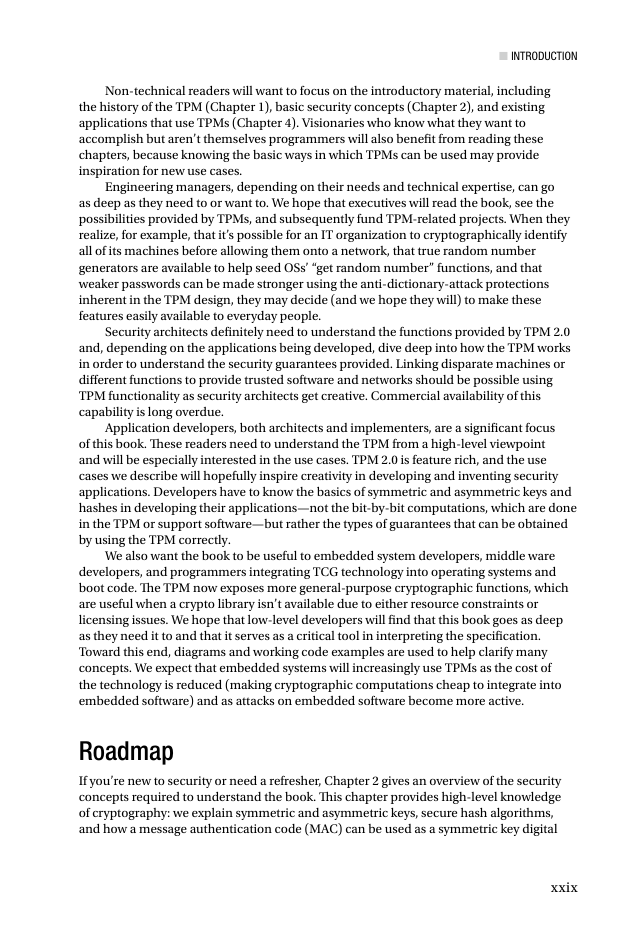
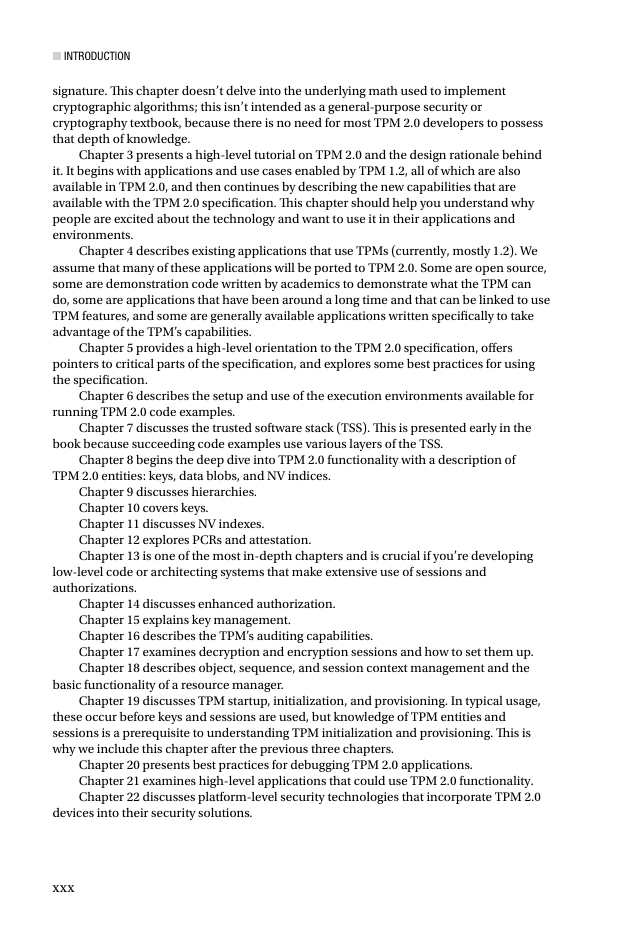








 2023年江西萍乡中考道德与法治真题及答案.doc
2023年江西萍乡中考道德与法治真题及答案.doc 2012年重庆南川中考生物真题及答案.doc
2012年重庆南川中考生物真题及答案.doc 2013年江西师范大学地理学综合及文艺理论基础考研真题.doc
2013年江西师范大学地理学综合及文艺理论基础考研真题.doc 2020年四川甘孜小升初语文真题及答案I卷.doc
2020年四川甘孜小升初语文真题及答案I卷.doc 2020年注册岩土工程师专业基础考试真题及答案.doc
2020年注册岩土工程师专业基础考试真题及答案.doc 2023-2024学年福建省厦门市九年级上学期数学月考试题及答案.doc
2023-2024学年福建省厦门市九年级上学期数学月考试题及答案.doc 2021-2022学年辽宁省沈阳市大东区九年级上学期语文期末试题及答案.doc
2021-2022学年辽宁省沈阳市大东区九年级上学期语文期末试题及答案.doc 2022-2023学年北京东城区初三第一学期物理期末试卷及答案.doc
2022-2023学年北京东城区初三第一学期物理期末试卷及答案.doc 2018上半年江西教师资格初中地理学科知识与教学能力真题及答案.doc
2018上半年江西教师资格初中地理学科知识与教学能力真题及答案.doc 2012年河北国家公务员申论考试真题及答案-省级.doc
2012年河北国家公务员申论考试真题及答案-省级.doc 2020-2021学年江苏省扬州市江都区邵樊片九年级上学期数学第一次质量检测试题及答案.doc
2020-2021学年江苏省扬州市江都区邵樊片九年级上学期数学第一次质量检测试题及答案.doc 2022下半年黑龙江教师资格证中学综合素质真题及答案.doc
2022下半年黑龙江教师资格证中学综合素质真题及答案.doc